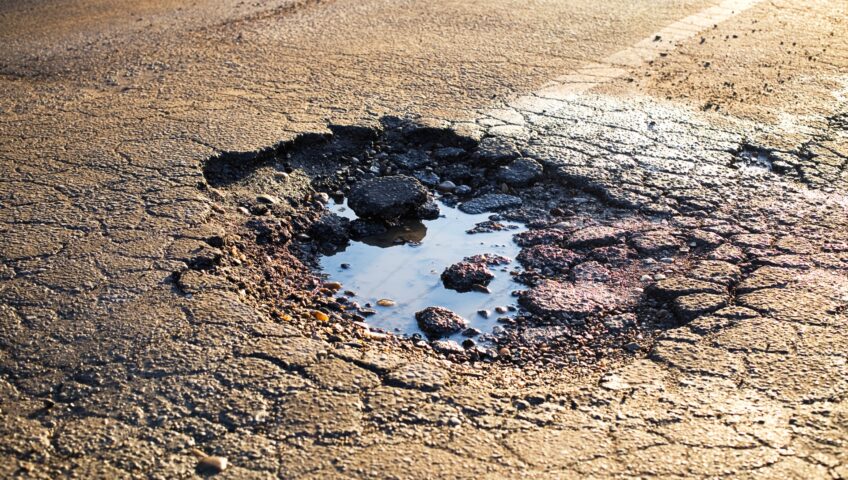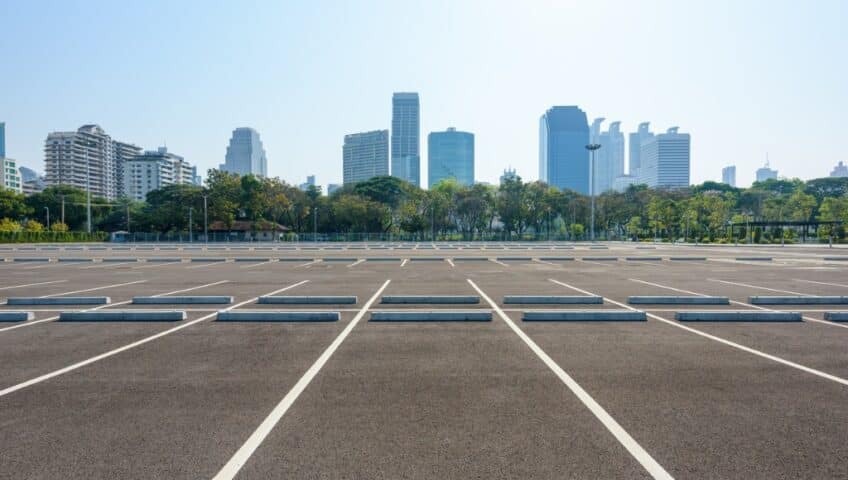
How to Address Water Ponding on Your Parking Lot
Puddles of water in the parking area of your building may appear unsightly but harmless. Still, water ponding on your parking lot may actually be indicative of problems with your asphalt or concrete paving. Note that most commercial parking lots are made from asphalt.
Standing water is likely to shorten the life of your pavement. If there is a crack or other break, water will enter and may end up eroding and destabilizing the pavement’s base. This could result in potholes, alligator cracks, large cracks, and more, leading to expensive repairs.
What Exactly Is Water Ponding?
Water ponding refers to puddles that form in pavement depressions due to a variety of reasons, including the following.
- Normal wear over time that causes ruts to form.
- Trucks or heavy equipment driving or parking on your lot if it was not designed to support such loads.
- The asphalt not being correctly compacted when it was applied.
- Subsidence or shifting of the soil underneath the parking lot.
- A drainage system inadequate to cope with the volume of rain that falls in your area.
- Ineffective sloping of your pavement.
- Neglected oil spills. As the oils dry out, the pavement begins to lose flexibility, and depressions and cracks may start to form.
- The wearing away of the seal coating caused by the weight of enough vehicles driving through an area of standing water.
- An improperly set blade on a snowplow taking out a chunk of asphalt.
Water Ponding Affects Safety
Standing water in your parking lot is unwelcome for several reasons, including the following.
- Vehicles that don’t or can’t avoid the puddles can give pedestrians an unwelcome splashing.
- Other car owners may not appreciate the drenching their vehicles receive.
- Severe pavement damage concealed by ponding water may result in impairment to vehicle tires or suspension systems.
- Pooling water can conceal cracks and potholes that could cause pedestrians to trip, sprain ankles, or suffer other injuries.
- Cyclists could take nasty falls or suffer damage to their bikes.
- During the colder months, water ponding on your parking lot can freeze, creating an icy hazard for both pedestrians and drivers.
Click here for some advice on making your parking lot as safe as possible.
Water Ponding Is Not Aesthetically Appealing
Puddles of water make your parking lot look blotchy and unattractive and may create an unfavorable first impression of your business to potential customers and investors. If the puddles also contain mud or dirt from runoff, the standing water is even less attractive.
Why Good Parking Lot Drainage Is Important
Water is absolutely necessary for life, but water will spell the death of your parking lot if it doesn’t drain off efficiently. Over time, ponding water will inevitably cause a breakdown of the asphalt and eventually lead to the deterioration of the bonding between the binder, rocks, and sand that together make up your pavement.
Water accumulating below the surface of your parking lot will gradually weaken your pavement and reduce its ability to handle its traffic load. Eventually, cracks will materialize, potholes will form, and your once-gorgeous parking area will turn into a hazardous eyesore.
How to Address Water Ponding Problems
The first thing to do is to have your parking lot inspected by a reputable contractor. Based on what the inspection finds, various corrective methods can be used, including the following.
- Pothole repair to prevent the holes from deepening and widening and creating a greater hazard.
- Patching if the problem is confined to small areas.
- Crack sealing during the spring and summer months to maintain the quality, appearance, and structural integrity of your pavement. Asphalt is porous, so water from melting snow and ice can infiltrate below the surface, causing minor cracks to form.
- Infrared treatment to melt the surrounding asphalt to enable new asphalt to be mixed in.
- Installation of trench drains or a system of curbs and gutters to improve your drainage.
- Milling and overlay to add a new layer of asphalt over the top of your existing pavement to improve its strength, performance, and curb appeal. This procedure is more on the rehabilitative side of the spectrum rather than the preventative maintenance side.
Can You Prevent Water Ponding on Your Parking Lot?
You can follow certain procedures to help prevent depressions from forming that will allow water to pool on your pavement. These steps include the following.
- Prohibiting trucks from driving through your parking lot. Provide separate access to your loading dock.
- Not allowing trucks or heavy equipment to park on your lot, especially if they need to remain stationary for several days. The weight of heavy loads can result in the deformation of your asphalt and leave depressions behind. If you must use your parking lot for palletized materials, move them to a different spot periodically, especially during the hot months.
- The prompt removal of automotive fluid, such as oil, by means of a regular cleaning schedule.
- Keeping storm drains and/or catch basins free from debris. If they clog, water will likely back up and pool on your pavement.
- Placing snow piles strategically, i.e., as close as possible to your lot’s storm drain.
About South Central Sealing & Paving
Are you ready to keep your parking lot in optimal condition for a long life? Then get in touch with our team at South Central Sealing & Paving. We specialize in full-service parking lot maintenance and repairs, including patching, crack sealing, sealcoating, overlays, and more. Our experts can maintain the integrity of your parking lot without disrupting your business because we do it the right way the first time – no need for constant repairs.
South Central Sealing & Paving offers a wide range of asphalt- and concrete-related services to customers in the Wichita, Kansas area. If you are having ponding water problems on your parking lot, don’t wait until they get worse. Contact us for a free, no-obligation estimate!




Recent Comments